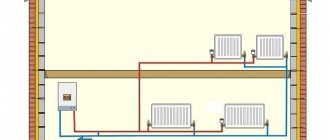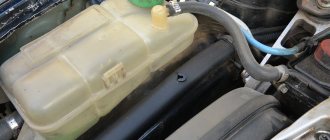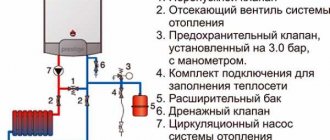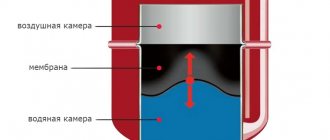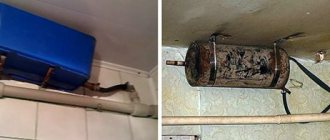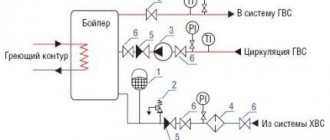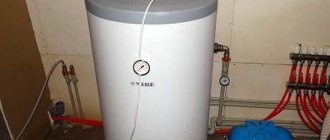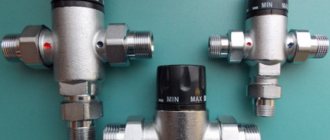The change in pressure during thermal expansion without taking into account the deformation of the system elements can be calculated using the formula: Δp = βt · Δt / βv, where βt is the coefficient of thermal expansion of water, 1/°C; Δt – change in water temperature, °C; βv – coefficient of volumetric compression of water, 1/Pa. Calculations show that in a rigid closed system, the pressure change is about 3 bar/°C. If we take into account pipe deformations, the results will be as follows:
|
How does the VALTEC expansion tank work? The expansion membrane tank contains a diaphragm that divides it into two parts, one of which contains nitrogen, which is under initial excess pressure, and the other part receives excess coolant from the system.
Initially, the entire volume of the expansion tank is completely occupied by nitrogen; When the coolant is heated, its volume increases, which leads to nitrogen compression. The pressure of the nitrogen blanket increases and equalizes the pressure in the heating system at a given static level. When the temperature of the coolant and, accordingly, its volume decreases, the pressure of the nitrogen blanket returns the coolant back into the system, preventing the pressure in the system from falling below the set level.
| Under operating conditions, the inner surface of the membrane expansion tank body is often an area of possible condensation. If there is oxygen in the gas cushion, intense corrosion of the metal of the tank body will inevitably begin. That is why manufacturers pump neutral nitrogen into the tank, and not atmospheric air containing water vapor and oxygen. By pumping air into the gas cavity, the user unwittingly shortens the service life of the membrane tank. |
Connection point of the VALTEC expansion membrane tank to the heating system
The pressure at the point of connection of the membrane tank to the system is always equal to the static pressure at a given point at given temperature parameters.
| Proving the above statement is very simple. If we assume that the pressure at the tank connection point changes, then we will have to admit that the volume of coolant in the tank has also changed. But this cannot be, because... There was nowhere for excess coolant to come from in a closed system, and there was no way it could disappear without a trace either. It should be noted that this rule only applies to a system with one expansion tank. |
Thus, the operating parameters of all other elements of the heating system, the required initial pressure in the expansion tank and the volume of the tank itself depend on the location of the expansion tank.
| When choosing the location for connecting the expansion tank, remember that the higher the pressure in the heating system, the less likely it is to become airborne. |
| If the membrane tank is connected to the system directly after the circulation pump, you should check that an anti-cavitation pressure reserve is maintained in front of the pump. |
In Fig. 1 shows several options for connecting a membrane tank to a heating system with the following height parameters:
- excess of the top point of the system over the bottom (H) – 10 m;
- the heat generator and safety valve are located 2 m above the lowest point of the system (h1);
- the expansion tank is placed 1 m above the point of its connection to the system (h2);
- static pressure at the lowest point of the system is 15 m of water. Art.
Rice. 1. Options for connecting the membrane tank to the heating system
At the remote flags in Fig. 1 indicates the calculated values of operating pressure at characteristic points of each system (in m of water column).
The safety valve setting value is assumed to be 33 m water. Art., pump pressure – 6 m water. Art., system capacity – 200 l. The difference between the maximum and minimum temperatures of the coolant is 80 ºС.
In table 1 shows the calculated characteristics of membrane tanks for circuits with their different connections.
Table 1. Calculated data for systems in Figure 1
| Scheme in Fig. 1 | Estimated preliminary pressure in the tank, m water. Art. | Estimated tank capacity, l | Brand of selected tank VALTEC |
| A | 13 | 14,9 | VRV18 |
| b | 13 | 14,9 | VRV18 |
| c | 11 | 14,2 | VRV18 |
| d | 11 | 14,2 | VRV18 |
| e | 3 | 11,5 | VRV12 |
| f | 3 | 11,5 | VRV12 |
| When installing a membrane tank in a gravity heating system on the upper line, it should be shifted from the main riser towards the heating risers in order to eliminate the parasitic effect on the circulation of the coolant cooling in the tank. The main riser must be equipped with an air vent and a safety valve (Fig. 1f). |
The coolant must enter the membrane tank from above. In this case, there is no chance of air getting into the liquid compartment of the tank. If this requirement cannot be met, it is recommended to follow these rules:
Rice. 2. Options for organizing the release of air from a system with a membrane tank |
Why is it needed?
Practically, all coolants for heating systems are weakly compressible liquids.
Accordingly, there is a need to use stabilizing devices - membrane expansion tanks for the heating system (operating principle), capable of accepting part of the liquid when volume and pressure increase, and returning it to the circulation circuit when these indicators decrease.
To compensate for the volume of coolant in the system when the temperature changes, expansion tanks are used.
Among them there are 2 types of devices:
- open;
- closed (sealed);
Open expansion tanks have become widespread, but are gradually giving way to sealed heating systems, since they have a number of disadvantages:
- additional installation costs, since they are installed at the top point of the system to create the required level of excess pressure;
- loss of coolant due to natural evaporation, and, as a result, the need to constantly monitor the liquid level and top it up;
- the danger of the development of corrosion processes in the system due to constant contact of the heated coolant with oxygen in the air.
Do you know which pond pump to buy? Read this useful article about the best equipment for artificial ponds.
What kind of air compressor is needed for a pond is written on this page.
Sealed expansion tanks do not have such disadvantages.
Advantages and disadvantages
The rubber is hermetically sealed, so air does not enter the system.
The main advantage of the equipment is the prevention of leaks and other emergency situations that occur during pressure surges. Tanks are necessary in long circuits. They contain a significant volume of water, which, when expanded, creates an increased load on joints, radiators and pipes.
Advantages of the equipment:
- prevents air from entering the line;
- the equipment is designed for water of any quality;
- there is no evaporation of liquid;
- emergency pressure rise is prevented;
- installation possible anywhere;
- Maintenance of the system is simplified; regular refilling of coolant is not required.
The disadvantages include heat loss and the rather high cost of membrane tanks compared to open-type tanks.
Design and principle of operation
The design and principle of operation of the device become clear from the name “membrane tank”.
It represents a hermetically sealed metal container, which is divided into 2 chambers by an elastic membrane.
One of them, the pneumatic chamber, contains air or gas under pressure. Coolant enters another hydraulic chamber (about plastic water tanks written here).
The device works as follows:
- in a state of equilibrium, the air pressure in the pneumatic chamber compensates for the liquid pressure in the heating system, the volume of the hydraulic chamber and the coolant in it is minimal;
- when the fluid pressure in the system increases (including during heating), the pressure in the hydraulic chamber increases, where excess coolant begins to flow;
- due to the elasticity of the membrane, the volume of the pneumatic chamber decreases, accompanied by an increase in gas pressure in it;
- as soon as the increase in pressure in the pneumatic chamber compensates for the increase in pressure in the hydraulic chamber, the system returns to equilibrium.
When the coolant pressure decreases in the heating system lines, reverse processes occur.
The air (gas) compressed in the pneumatic chamber expands, displacing liquid from the hydraulic chamber into the system until the pressure difference is compensated.
This hermetic design eliminates contact of the coolant with air, which significantly reduces the likelihood of the development of corrosion processes not only in the tank itself, but also in other elements of the heating system - boilers, pipelines, etc.
In addition, expansion tanks (sealed expansion tanks) in accordance with SP 41-101-95 “Design of Heating Points” are equipped with safety valves (safety valves), which allow limiting the maximum pressure in the system to a level acceptable under operating conditions.
Due to this, the expansion tank acts as a protection device for the elements of the heating system.
Design features
The purpose of the membrane expansion tank is that at all operating stages the device must maintain a balance between the pressure of both parts and, if necessary, level off excessive pressure or regulate its differences in the heating structure. Thus, the installation of a membrane expansion tank prevents the occurrence of increased loads in the heating circuit and in emergency situations in the event of malfunctions.
The device comes with a replaceable or non-replaceable membrane. In the first case, the coolant is completely contained in the flexible membrane container and cannot interact with the steel inner surface. All work associated with dismantling and subsequent installation of a new product is carried out through a flange secured with bolts.
If you purchase a device with a fixed diaphragm, it has an internal cavity consisting of two parts. In this case, a non-replaceable diaphragm membrane is used, which is rigidly fixed. A membrane tank for the heating system is selected directly for a specific heating structure, taking into account the amount of coolant. If the volume of the device turns out to be insufficient, the consequences can be very negative - cracks often appear and water can leak through the threads. In addition, the pressure in the system often drops below the permissible norm, as a result of which air gets inside the tank. Therefore, the choice of device must correspond to the necessary design parameters (for more details: “We are making the selection of an expansion tank for heating”).
An expansion membrane tank for heating systems is used to create closed-type coolant circulation in order to compensate for its thermal expansion as a result of an increase or decrease in fluid temperature, thereby preventing water hammer. In constant mode, both chambers of the device - water and gas - have the same pressure, which makes it possible to maintain the tightness of the system. This arrangement of the expansion tank of the heating system has been time-tested and recognized as the most practical.
The water circulating through the circuit does not contain aggressive gases and therefore corrosion will not render the tank unusable, which allows it to be used for a long time. The pressure expansion device is placed in the boiler room, and for this reason there is no need to protect it from freezing.
Despite the fact that the selection of a tank for a heating structure is individual, one should not forget that:
- the initial pressure in the membrane tank for heat supply connected to the cold water supply must exceed the static pressure in the system by 30-50 kPa;
- The device must have a reserve amount of coolant to compensate for possible leaks.
To protect a closed-loop system with an expansion tank from too high pressure, safety valves are installed.
Differences from a hydraulic accumulator
The design of sealed expansion tanks is similar to the design of hydraulic accumulators, however, the purposes of these devices are different. The expansion tank compensates for the expansion of water that occurs due to heating in the heating system. The hydraulic accumulator accumulates the volume of water under pressure in a water supply system that has a pressure pump in order to reduce the frequency of activation of this pump and smooth out water hammer. In addition, more often than not, inside the accumulator there is a bulb made of food-grade rubber. It is this that is pumped with water; as a result, the water does not come into contact with the tank body. The expansion tank for heating systems is made with a membrane made of technical rubber. It divides the housing into two compartments, and the coolant has contact with the housing.
Types of hydraulic accumulators
For heating systems, manufacturers produce tanks that differ in membrane design.
Membranes for expansion tanks are divided into:
- balloon;
- diaphragm.
The diaphragm membrane is a permanent partition made, most often, of thin metal or elastic polymer.
The main difference between this option is its small internal capacity and the ability to compensate for minor pressure drops in the system.
If such a tank malfunctions, it must be completely replaced.
The advantages of such devices include simplicity of design, reliability in operation and low price.
The balloon-type membrane is a container installed inside the tank made of high-quality rubber that is resistant to significant temperature changes.
A flange fastening of the membrane is used, which allows for its simple and quick replacement (how to install pipeline shut-off valves with your own hands is written here).
The advantages of balloon membranes include:
- wide range of operating pressures at which the use of a sealed expansion tank is allowed;
- the ability to replace the membrane , thanks to which repairing the device (about a manual pipe cutter for plastic pipes is written here) becomes faster and cheaper;
- ease of setting the minimum (set) pressure for any system.
The model ranges of tanks with replaceable membranes produced by manufacturers cover a wide range of not only pressures, but also volumes.
At the same time, devices are available in various designs, for horizontal and vertical installation, with mounting on building structures or installation on legs, which significantly increases the flexibility of designing heating systems.
Popular models
Expansion tanks of the Wester brand for hot water supply and heating are painted red.
The Russian brand Wester produces membrane tanks for cold and hot water supply, as well as heating. The WRV series is designed to compensate for the expansion of the coolant. It includes models of various capacities - from 8 to 10,000 liters. The body of the products is painted red.
Wester WRV 50
The device is used in closed heating systems. Its volume is 50 l. The housing is positioned vertically, installation is floor-mounted. The model is made from durable carbon steel. The membrane is made of food-grade synthetic rubber. It is replaceable; a flange on the neck of the tank allows you to install and fix a new elastic part. The design is designed for pressures up to 5 bar.
Wester WRV 200 top
Membrane tanks for heating Wester wrv200 top are made of complex drawn steel. Heat-resistant elastic EPDM rubber is used to separate the inner chamber. The part is replaceable. Operating temperature range from -10 to +100°C. The design can withstand pressure up to 10 bar, its volume is 200 liters. Floor placement.
The expansion tank is a simple in design, but functional part of the heating system. Prevents breakdowns caused by sudden increases in pressure. Its installation will ensure safe and stable operation of all working units.
Device nuances
The functions performed by the membrane for the expansion tank determine the features of its design. It is a metal body in the form of a cylinder, the internal space of which is divided into two parts. One of them contains gas or air. They are compressed to a certain level, the value of which is indicated in the technical data sheet. The other cavity, which is formed by the replaceable membrane of the expansion tank, is filled with water. Thanks to this, the gas pressure will coincide with the same parameter in the pipes.
The raw material for the manufacture of the tank body is steel, onto which a protective red paint coating is applied. This finish prevents rust and helps provide visual separation from blue epoxy painted accumulators. The rubber membrane of the tank is made from synthetic rubber using the casting method, which allows the production of products with a spherical or pear-shaped configuration. The basis for the production of elastomer is ethylene and propylene, subjected to polymerization. The finished material is characterized by the following:
- resistance to high temperatures;
- the ability to deform under load and restore its original shape in its absence;
- inertness to chemicals;
- good elasticity.
Typically, the heating expansion tank membrane is suitable for installation in products from different manufacturers (for all manufacturers they are the same size and interchangeable).
The exception is the Wester brand (their membranes are suitable only for tanks of the same name and cannot be replaced by any others).
Air pressure in the tank
The water or coolant in the heating system is always under pressure. In private houses it is 1.6-2 atm., in multi-storey houses - many times more. To ensure that the coolant does not lose pressure during normal operation, the upper part of the expansion membrane tank must be filled with air.
The air pressure in the upper chamber should be 0.2 atm. lower than the coolant pressure in the system. A regular bicycle or car pump is suitable for pumping air. The only thing you may need is an adapter.
At the top of the expansion tank there is a nipple with a spool. The operating principle is the same as in car or bicycle wheels. To deflate the air, just press the small tongue inside it.
Some manufacturers fill the tank not with air, but with nitrogen. In fact, this will not change the effectiveness of its work at all. This is an advertising ploy - they are trying to force you to buy more expensive equipment.
Calculation of the expansion tank using the formula
If you do not want to go into details, you can install a tank with a capacity of 10% of the total coolant volume. But sometimes it’s better to calculate everything exactly. By equipping a large heating system, you can save a lot.
To calculate the required volume of the expansion tank, you need to know the following:
- Minimum coolant temperature;
- Maximum coolant temperature;
- Heating system volume;
- The percentage of ethylene glycol or propylene glycol in the coolant.
Important! If you are going to heat a house or cottage where you do not live permanently, be careful when selecting the type of coolant. They have different freezing temperatures and expansion coefficients.
To calculate the volume of the expansion tank you need to use the formula:
V = V1 x ( Q – Q1)
In this formula:
- Q1 – expansion coefficient at minimum temperature (see tables below);
- Q – expansion coefficient at minimum temperature (see tables below);
- V1 – volume of coolant in the heating system in liters;
- V – volume of the expansion tank in liters.
If an expansion tank is already installed in the heat source, then it must be taken into account. To do this, subtract the built-in capacity from the obtained “V” value. The resulting number is the required volume of your expansion tank.
Important! If you have a heating system with forced circulation, the minimum total capacity of the expansion tank is 15 liters.
Thermal expansion coefficient of ethylene glycol solution
| t, °С | 10% | 20% | 30% | 40% | 50% | 60% | 70% | 80% | 90% | 100% |
| 0.00013 | 0.0032 | 0.0064 | 0.0096 | 0.0128 | 0.016 | 0.0192 | 0.0224 | 0.0256 | 0.0288 | |
| 10 | 0.00027 | 0.0034 | 0.0066 | 0.0098 | 0.013 | 0.0162 | 0.0194 | 0.0226 | 0.0258 | 0.029 |
| 20 | 0.00177 | 0.0048 | 0.008 | 0.0112 | 0.0144 | 0.0176 | 0.0208 | 0.024 | 0.0272 | 0.0304 |
| 30 | 0.00435 | 0.0074 | 0.0106 | 0.0138 | 0.017 | 0.0202 | 0.0234 | 0.0266 | 0.0298 | 0.033 |
| 40 | 0.0078 | 0.0109 | 0.0141 | 0.0173 | 0.0205 | 0.0237 | 0.0269 | 0.0301 | 0.0333 | 0.0365 |
| 50 | 0.0121 | 0.0151 | 0.0183 | 0.0215 | 0.0247 | 0.0279 | 0.0311 | 0.0343 | 0.0375 | 0.0407 |
| 60 | 0.0171 | 0.0201 | 0.0232 | 0.0263 | 0.0294 | 0.0325 | 0.0356 | 0.0387 | 0.0418 | 0.0449 |
| 70 | 0.0227 | 0.0258 | 0.0288 | 0.0318 | 0.0348 | 0.0378 | 0.0408 | 0.0438 | 0.0468 | 0.0498 |
| 80 | 0.029 | 0.032 | 0.0349 | 0.0378 | 0.0407 | 0.0436 | 0.0465 | 0.0494 | 0.0533 | 0.0552 |
| 90 | 0.0359 | 0.0389 | 0.0417 | 0.0445 | 0.0473 | 0.0501 | 0.053 | 0.0557 | 0.0584 | 0.0613 |
| 100 | 0.0434 | 0.0465 | 0.0491 | 0.0517 | 0.0543 | 0.0569 | 0.0595 | 0.0621 | 0.0647 | 0.0673 |
Volume calculation
The expansion tank by volume should contain 10% of the total coolant in the system.
The parameters of the tank should prevent pressure from rising when the coolant is heated. For an approximate calculation of a system with a capacity of up to 150 liters, you can use the formula: tank volume - 10% of the system volume. If antifreeze is used, the parameter increases to 15%. For calculations you will need loop capacity. You can find out the parameter using the water meter during the process of filling the system. It is also calculated by adding up the volume of all components, pipes, radiators and boiler. There are online calculators for calculations.
A more accurate value will be obtained by calculating using the formula: V = V1 x Bt/(1-(Pmin/Pmax)), where:
- V – volume of the tank;
- V1 – volume of liquid in the circuit;
- Bt – coefficient of thermal expansion of the coolant, found from the table;
- Pmin – factory pressure in the tank;
- Pmax is the maximum pressure in the system, determined at the moment the safety valve is activated.
The correctly selected volume of the expansion tank helps extend the life of the heating system.
Restrictions
Manufacturers impose certain restrictions on the use of membrane expansion tanks, which depend on the design and materials used in the manufacture of the device. Manufacturers have clear requirements for the properties and composition of the liquid in the heating system. The content of, for example, ethylene glycol in an antifreeze solution is limited. The use of a membrane expansion tank at pressures exceeding permissible standards is prohibited. It is mandatory to install a safety group that controls and limits the pressure in the tank. The heating systems of autonomous heating apartments and private houses use equipment with an operating pressure of at least 3 bar.
How does an open expansion tank work?
An open expansion tank is simply a container partially filled with coolant. Sometimes there is not even a valve for air to escape, but just a hole.
Open expansion tanks have two big disadvantages. First, they are susceptible to corrosion because they come into contact with open air. Secondly, they can only be installed in systems with natural circulation.
If you have a circulation pump installed that circulates coolant through the system, then it will not go further than the open expansion tank. The coolant will simply fill the tank and overflow.
How to install?
When installing an expansion tank for water supply, it is important to know:
- the tank is mounted in such a way that it is easy to maintain and pipes are easy to change;
- the diameter of the pipes connected to the tank is selected not less than the diameter of the tank pipes;
- the equipment must be grounded;
- There must be no obstacles or elements that interfere with the standard pressure between the pump and the connection point.
The liquid flows to the boiler through a valve, which prevents the release of hot water into the cold water supply system. The tank is installed between the boiler and the valve. This way, hot water will come straight from the tap. Sometimes the tank is mounted after the boiler, but then cold liquid from the tank will first flow into the hot water supply.
Operating principle of a closed (membrane) expansion tank
The design of a closed expansion tank differs from a closed one in the presence of a membrane. It is impermeable to air and coolant and divides the container into two parts.
The operating principle of a membrane expansion tank is simple. When the coolant heats up, it increases in volume. Under pressure, the membrane rises. This increases the total volume of the heating system and does not put additional pressure on it.
When cooled below a set temperature, the coolant contracts. The membrane lowers and the volume of the heating system decreases. This compensates for the vacuum created by compression of the coolant.
Requirements and recommendations for installing a membrane tank
Small volume tanks are wall mounted
You can install the equipment yourself by following the instructions. When working, adhere to the installation requirements:
- The first stage is choosing a location. It is necessary to ensure free access to the tank for maintenance. A good place is considered to be the section of the return line between the pump and the boiler.
- To ensure the safety of a closed circuit, you will need to install a safety valve, an air vent, a pressure gauge and a thermometer.
- A drain valve is installed in front of the inlet pipe to drain water from the tank.
- Filters must not be installed in the area connecting the tank and the heating system.
- Before connecting the equipment, check the pressure of the gas space. If necessary, pump up air.
- The tank should not be located in a room with sub-zero temperatures.
The tank is securely mounted on the wall, and no additional load should be placed on it. Large volume models are mounted on the floor. A connection diagram with the inlet pipe located at the bottom is recommended. Experts advise making a detachable connection between the pipe and the drain valve in front of it. If necessary, the expansion tank can be easily dismantled.
The manufacturer specifies the requirements for the amount of antifreeze in the coolant. The stated proportions must not be exceeded.
Benefits of using closed appliances
- Small dimensions of the tank, easy installation and maintenance of the tank.
- Tightness (evaporation is excluded, replacement of water with antifreeze is acceptable).
- There is no danger of underfilling (overfilling) or freezing.
- Accelerated heating, automatic regulation.
- Regulation of pressure surges.
- Slight temperature fluctuations in the boiler connection areas.
- No heat losses.
- Adding or decreasing room temperature.
- Installation in a place free for access.
- Narrow pipe diameter – cheaper cost.
The main advantage is versatility: it is possible to include a boiler, convector heater, heated floor, and radiators of different configurations into the system.
How to choose the right membrane expansion tank?
In order for the heating system to operate stably, the tank for it must be selected based on calculations. The correct pressure cannot be generated if the reservoir is larger than necessary; and if it is smaller, it will not accommodate excess liquid, which can lead to an accident.
For the product to work properly, you need not only to correctly select its volume, but also take into account other characteristics. Particular attention should be paid to the following factors:
- the membrane must be resistant to extreme temperatures and pressures or their differences;
- the model must comply with sanitary and hygienic standards;
- tank installation method.
The Russian market offers a large number of expansion tanks of Russian and foreign production, which vary in cost. You should not purchase the cheapest models - such a price may be due to the use of low-quality materials in production. Domestic tanks are cheaper than their foreign counterparts, but are not inferior to them in terms of performance characteristics.
The main characteristic that you should focus on when purchasing an expansion tank is its volume. The standard recommendation is the following: choose a product whose size is 10% of the total volume of coolant in the heating system. Since the coefficient of thermal expansion of the coolant, even with high heating, cannot be higher than 0.08, such a volume of the hydraulic accumulator will be quite sufficient. Calculations before purchasing a product should include the following indicators:
- coolant volume;
- coefficient of thermal expansion;
- maximum permissible pressure of the heating system;
- initial pressure in the tank.
When calculating the total volume of coolant, it is necessary to take into account all components of the heating system. This information is obtained from the building design documentation. In the absence of such documents, you can perform an approximate calculation, taking as a guide that 1 kW is required to heat 15 liters of water.
The coefficient of thermal expansion of the coolant is calculated by its temperature or determined by the composition of the liquid - in apartment buildings it often contains glycols, which improve its characteristics.
The maximum pressure of the heating system is determined using the minimum pressure value allowed for its components. The transfer valve is adjusted to this indicator.
The initial pressure in the heating system with a cooled coolant corresponds to the minimum pressure. To control the initial pressure in the tank, the accumulator is equipped with a pressure gauge. Also, a safety group must be installed on the expansion tank, which limits and controls the pressure.
The use of a membrane tank for heating has a number of limitations depending on the design and material from which it is made. Some models have strict requirements for the composition of the coolant, in particular, they limit the amount of antifreeze and ethylene glycol in its composition.
Please note: expansion tanks cannot be used if pressure limits are exceeded.
Equipment selection rules
It is important to choose the right tank volume in order to adjust the pressure in the system.
The main characteristics of a membrane tank, which are oriented towards when purchasing:
- volume;
- maximum pressure;
- membrane and housing material;
- working temperature.
These criteria will ensure reliable heating operation. Insufficient or excessive tank volume will not allow normal pressure to be established in the circuit. The type and material of the membrane and housing affect the service life of the equipment. High-quality rubber can withstand a large number of expansion and compression cycles. To prevent the body from corroding, it must have a protective coating. It is worth considering the dimensions of the product and considering the installation location. Experts advise buying products from well-known manufacturers. Low product costs are often an indicator of the use of low-grade materials.
Possible breakdowns
With prolonged use, the membrane may burst
During operation of the equipment, owners are recommended to inspect the housing for leaks and damage every six months. It is also necessary to measure the pressure in the gas chamber. The condition of the membrane is checked once every 2 years. If there is no use for a long time, the water is drained from the tank.
Common faults:
- Pressure drop in the gas compartment - it is necessary to pump air through the nipple using a pump.
- Damage to the housing - mechanical stress or corrosion can cause a crack to appear. The seal of the container can be restored at a service center.
- Leaking from the air valve - due to high loads and hot water, the rubber may crack. It is better to replace the damaged part in a timely manner.
You can repair the equipment yourself. To replace the membrane, you will need to drain the water, remove the container and relieve the pressure. Then unscrew the flange bolts holding the rubber part. The old membrane is removed and replaced with a new one. All procedures are carried out in reverse order.
Common faults
Typically, most problems are not related to the container itself. Not so often there are cases when the tank itself cracks and begins to leak for no obvious reason. However, even taking into account the simple design, the problem part may well be the cap of the expansion tank of the engine cooling system.
The valve built into the lid may fail. Insufficient sealing may also occur due to deformation of the rubber ring. As a result of such malfunctions, the cap may begin to leak antifreeze, the system may become airy, etc.
If the valve in the cover begins to work incorrectly, then in such a case deviations in the operation of the internal combustion engine cooling system are inevitable. In addition to the formation of air locks, this situation in some cases leads to a critical increase in pressure and rupture of the expansion tank. In such a situation, the tank needs to be replaced with a new one. It is not recommended to attempt to restore a damaged container by sealing cracks.
If we talk about the cover, its damage and defects, as well as malfunctions of the valves due to clogging or deterioration, are a reason to replace the cover. In some cases, the lid is cleaned in an attempt to restore functionality, but this method does not always work. Given the low cost, it is better to replace the element immediately.
The procedure and conditions for installing the tank
The membrane accumulator can be installed independently, without the involvement of a specialist. The list of requirements for installing the device is as follows:
- The device must not be installed in places with sub-zero temperatures;
- the expansion tank can be installed at any point in the heating system before it is branched;
- the fastening must be as reliable as possible, since a filled tank becomes very heavy;
- connections must be sealed, but sealants cannot be used, since they will worsen friction between the tank body and the membrane;
- Do not install the tank on the outlet pipe in the immediate vicinity of the heating boiler.
If the hydraulic accumulator capacity has a volume of 30 liters or more, it is prohibited from attaching it to supporting structures. Most often, such tanks are equipped with special legs, which allow them to be installed directly on the floor. During installation, the following conditions must be observed:
- the pipe must have a three-quarter (inch) circumference; accordingly, a similar threaded channel must be present in the return pipeline;
- any external load on the tank must be excluded;
- paronite gaskets that are resistant to high temperatures or pressure should be used;
- In order to regulate or maintain the required pressure in the gas compartment, the expansion tank must be equipped with an air valve.
When installing the hydraulic accumulator, gross mistakes must not be made, otherwise the equipment will not function normally. The most common mistake is incorrectly calculated maximum pressure (which is about 90% of the critical pressure) in the gas compartment. Such a miscalculation leads to the fact that the membrane does not expand and does not allow excess coolant to pass into the tank. The result will be a pipe break and failure of the heating system. A high-quality pressure gauge installed on the hydraulic accumulator protects against such developments. If after calculations it turns out that the volume of the existing tank is not enough, you will need to purchase an additional small container.
The expansion tank in the heating system is very important, since it determines how correctly the system will work. Installing it is not difficult, but it is necessary to carry out the entire process as carefully as possible, since even a small mistake can provoke an emergency. In a closed heating system, high pressure is constantly applied to the membrane; throughout the entire heating season, this device experiences serious loads. Therefore, at least once every 2 years you should check its condition and, if necessary, replace this part and/or the expansion tank itself.
For protection against water hammer
Such a load represents a sharp jump in the speed of water flow, which occurs when the pipeline is unexpectedly blocked. A change in the number of atmospheres, in turn, can cause damage to pipes. In such a situation, the expansion tank acts as a damper: the membrane-partition stretches, which leads to an increase in the volume of the corresponding compartment of the tank, and the pressure decreases.
